Pirates' 2023 Minor League Recaps: Bradenton Marauders
A constantly changing, but hard-hitting cast . . . .
Bradenton had a good year, performance-wise, finishing 76-54. They did it despite a roster that went through major changes throughout the season due to injuries and promotions. For example, the Marauders had ten hitters with 100+ PAs with an OPS of .750 or better. Only one, Rodolfo Nolasco, played in 100 games, and at 102 he just barely made it. Only three others even reached 70. Minor league teams never have much stability — you don’t really want stability because you want to see players earn promotions. But Bradenton this year seemed extreme.
HITTERS
The flux didn’t stop Bradenton’s hitters from tying for the Florida State League lead in runs. (They were actually second in runs per game; four teams were bunched at the top within four runs of each other.) The Marauders led the FSL by wide margins in walks and strikeouts, and were second in home runs, second in steals (first in SB%), and first in OBP and OPS. Their hitters were the third youngest, by weighted average, in the ten-team league, at 20.5 years vs. the average of 21.0.
I mentioned that the FCL team had a number of position players who’d been demoted after struggling at higher levels. These included Juan Jerez, Sergio Campana, Jauri Custodio, and Javier Rivas. There was also Alexander Mojica, who got sent to the development list for the last two months of the season. With the possible exception of Rivas, it’s hard to see any of these players going anywhere, so I’m not going to discuss them. There were also a couple of players who got released, including Tanner Tredaway, who was drafted just last year.
The Top Guys
Termarr Johnson, 2B: Any discussion of 2023 Bradenton players starts here. He missed the first couple weeks due to a hamstring injury, then got off to a slow, 4-for-26 start. After that, he started hitting and eventually got an August 1 promotion to Greensboro. Despite playing less than two-thirds of a season, Johnson tied for sixth in the league in home runs (with 13) and was third in OBP (.420). What stands out with him, though, is that his hitting profile has changed dramatically since he was drafted. Ostensibly a guy with an elite hit tool, at both levels this year he was more of a three-true-outcome hitter. He seldom chases, leaving him with an extremely high walk rate (21.8% with Bradenton), good power, a surprisingly high K rate (26.7%) and a surprisingly low average (.244). The last results mainly from him swinging through pitches in the strike zone, which in turn may result from him trying to pull everything. When he makes contact, he makes a lot of very hard contact, although he hits the ball on the ground a little more than ideal. Johnson got a little time at short, but he’s clearly going to go forward at second, where he figures to be adequate.
Lonnie White, Jr, OF: Picking up where we left off, White arrived from the FCL on the Fourth of July. After a slow start, he began hitting baseballs hard. He finished fourth in the league (min. 129 ABs) in slugging at .488, and two of the players ahead of him (one of them Nick Cimillo) were 2-3 years older than him. White showed a lot of patience and finished with a .395 OBP. The strikeout rate (28%) was high, but it went down over the last couple months. White played all three outfield positions, but looked capable of handling center. The season was a big step toward becoming the player the Pirates were hoping to see for their $1.5M bonus.
Yordany De Los Santos, SS: De Los Santos moved up to Bradenton the same day as White, but things went very differently for him. He fanned 15 times in his first 24 ABs. He had a stretch where he hit well, but the strikeouts remained extremely high as he kept chasing pitches out of the strike zone. In 38 games with the Marauders, he had two with three strikeouts, four with four and one with five. De Los Santos finished with a .578 OPS for Bradenton. The Pirates put him on the development list about a week before the end of the season. De Los Santos didn’t have much trouble with chasing pitches in the FCL, so there’s no reason to believe he can’t address the problem.
Outfield Bats
Shalin Polanco: Through three pro years so far, Polanco has established a very consistent pattern of struggling initially at a new level, then starting to figure it out. Over the first three months, his OPS was .596, .755 and .910, in order. In July he got hurt and missed the last two months of the season. Polanco was expected to have power potential and, this year, it started to surface. By July, he was hitting the ball very hard, very often. His 12 home runs tied for eighth in the league despite all the missed time, and he won’t turn 20 until February. Polanco doesn’t take the wait-for-something-to-drive approach that characterizes the Pirates’ system from top to bottom. His walk rate was 9.6% and his K rate was 28.7%. He’s always looked capable in center to me, although he doesn’t have great speed, but scouts don’t seem to like him there.
Enmanuel Terrero: Terrero sharply changed his approach at the plate this year. In the past, he’s been a contact-oriented, high-average hitter with very modest power who walked a lot more than he struck out. This year he noticeably started swinging harder, trying to pull the ball more and chasing more pitches. He hit eight home runs after hitting just one in each of his first two years, one of those inside-the-park. His walk rate dropped, but was still high, and his K rate doubled, from 13.1% last year to 25.8%. Still, he hit 266/368/409, all well above the league averages.
Rodolfo Nolasco: Nolasco epitomizes the three-true-outcome pattern that dominates in the Pirates’ system. This year he led the FSL with 20 home runs and had a 16.0% walk rate, but he batted .215 and had a 34.2% K rate. He’s a very strong guy who puts up high exit velocities, but he was repeating the level and the swing-and-miss is probably why.
Heavy Hitters from the 2022 Draft
Jack Brannigan, 3B: Most scouts saw Brannigan as a better prospect on the mound, and the Pirates said when they drafted him that he’d be a two-way player, but there’s no sign of him pitching so far. One factor might be his plus defense at third. He didn’t hit well at Bradenton last year and the Pirates sent him back there this year, which isn’t great for a draftee from a major college. He got hurt early in the season and missed over a month, then went 0-for-16 when he returned. But then he started to hit and the power started to show up. He put up a .915 OPS in June and had eight hits in his first three July games. By late July he was in Greensboro. While in Bradenton, Brannigan started getting time at second and short, and looked like he could handle both positions. He also stole 17 bases in 19 tries. More on his stint with the Hoppers next time.
Nick Cimillo, C/1B: Cimillo also got sent back to Bradenton after appearing in eight games there in 2022. He got little playing time in April and May, but put up a .923 OPS in June and hit even better in July. That got him semi-regular, although not everyday, playing time. He easily led the FSL in slugging (129 AB min.) The Pirates promoted Cimillo to Greensboro at the beginning of August and high A pitching proved to be a completely different thing, as he managed only a .551 OPS in 19 games. He caught one game for the Hoppers and exactly one inning for the Marauders, instead splitting his time between first and DH.
Josiah Sightler, 1B: After not playing in his draft year in 2022, Sightler was on the injured list in 2023 until early June. After rehabbing in the FCL, he went to Bradenton and found the pitching comically easy to solve. He hit 516/563/891 in 18 games, then moved up to Greensboro. Like Cimillo, he had a different experience there. He hit 232/293/387 and saw his K rate go from 11.2% to 28.7%.
As a quick note, Tres Gonzalez was, oddly, sent back to Bradenton after batting .325 there last year. He put up an .830 OPS in 19 games and moved up to Greensboro.
Utility Infielders
Jesus Castillo, IF: Castillo led the Marauders in games played with 118. He played solid defense at second, third and short, as Bradenton constantly rotated the infielders. Castillo has an extremely patient approach at the plate and led the league easily in walks. He didn’t hit the ball with any authority at all, though, batting .209 with an ISO of .042. He stole 39 bases in 48 attempts.
Deivis Nadal, IF/OF: Nadal is a slick defensive infielder, although he can be erratic. He started off as a shortstop, but he’s become a utility player as he hasn’t hit well. This year the Marauders used him a lot in the outfield, which got him in the lineup almost every day. He looked like the Pirates’ infielders-in-the-outfield usually look: like an infielder in the outfield. He may, however, have the strongest outfield arm in the system, with Henry Davis now in the majors. Nadal is a slightly built guy who originally was a slap hitter who went one whole year without an extra base hit. This year he started taking a huge cut and trying to pull everything. The result was a low average and a whole lot of strikeouts, but he did hit for decent power over the season’s last three months.
Javier Rivas, SS: Rivas is a good, often spectacular defender at short, which earned him the rare distinction in the system of mostly sticking to one position. At the plate, Rivas has power potential in a wiry, 6’6” frame, but he hasn’t so far been able to stop chasing pitches out of the zone. He put up a .534 OPS in April and .518 in May, then got demoted after starting June 0-for-18. In the FCL, Rivas seemed to tone down his swing and managed a .762 OPS, then returned to the Marauders for the season’s last week and a half. His K rate for all his time at Bradenton was 39.1%.
Catchers
Geovanny Planchart: Planchart was the team’s primary catcher. He’s a capable defensive player with a very good arm; he threw out 33% of opposing base stealers, 11 points above the league average. He was very patient, with a 14.8% walk rate, but he didn’t hit well overall, with a 222/341/320 line.
Omar Alfonzo: Alfonzo’s father caught in the majors for several years and he was a moderately prominent signing, based partly on power potential. He’s a solid receiver, although the Pirates apparently don’t like him as much as they do Planchart. Alfonzo did have a 30% CS rate. He had a rough time at the plate in the FCL in 2022 and, after starting this year going 4-for-24 with Bradenton, the Pirates sent him back to the FCL. Alfonzo tore that league up and, after eight games, came back to the Marauders. He continued to hit well and had a power outburst in September, slugging .636 in ten games. The Pirates used Alfonzo a lot at first, evidently in deference to Planchart, but he started 26 games behind the plate.
Hitters from the 2023 Draft
Mitch Jebb, IF: The Pirates’ second round pick, Jebb got into 34 games after signing. At the plate, he was the guy we were told about: He hit for average, showed a very good eye and seldom swung and missed, but he also showed limited power. Jebb’s hitting style is similar to Ji Hwan Bae’s: He steps in the bucket as he swings, tries just to poke the ball over the infielder, and gets down the line very quickly. He batted 287/392/398 for Bradenton. Jebb divided his time evenly between short and second, with the latter probably being the more realistic spot. The Pirates may eventually try Jebb in center. He runs very well and stole 11 bases in 12 tries.
Charles McAdoo, 2B/OF: McAdoo was the Pirates’ 13th round pick. Nominally a second baseman, McAdoo played more often in left after signing and that’s a much more realistic spot for him. He got into 28 games overall and hit 302/412/510, with five home runs and very good walk and K rates.
Some other draftees got briefer looks. Third rounder and third baseman Garret Forrester got into just six games before he got hurt and missed the rest of the year. Infielder Kalae Harrison, an 18th round pick, had a .752 OPS and more walks than strikeouts in 18 games. Catcher Justin Miknis, a 16th rounder, hit .152 in 11 games.
PITCHERS
Starters Who Moved Up
Thomas Harrington, RHP: The Pirates drafted Harrington 36th overall in 2022. He didn’t pitch last year, but Baseball America ranked him tenth in the system. He’s a finesse righty who sits at 92-93 and has a high-spin slider and a change. Harrington didn’t have a tough time with hitters in the FSL, posting a 2.77 ERA in eight starts, along with good walk and K rates. His time at Greensboro tells us more. Same with th next two guys, so tune in then.
J.P. Massey, RHP: The Pirates drafted Massey in the seventh round even though his performance at the University of Minnesota was pretty awful. Scouts liked his stuff a lot, but command was a major issue. He sits at 91-95 and throws a lot of sliders and curves. In 11 games with Bradenton, he had a 3.28 ERA and 4.4 BB/9, which was better than the league average of 4.9. He did seem to rely heavily, though, on hitters chasing.
Derek Diamond, RHP: Diamond is another finesse righty. In college, his velocity dropped from the mid- to the low-90s from his sophomore to his junior season, which is why he was available in the sixth round. With Bradenton, he averaged a little over 92 with his fastball and relied a lot on a slider. With Bradenton, he got hit around some early in the season; opponents batted .269 against him, 30 points above the league average. Beginning in late June, he got on a good run of five starts with a 2.10 ERA (and nearly all the runs came in one start). That got him a promotion to Greensboro after 11 games with Bradenton.
Starters Who Stayed for the Season
Owen Kellington, RHP: Kellington didn’t pitch the year he was drafted and missed nearly all of last season with a hamstring injury, so it probably says something that the Pirates started him off at Bradenton. He was drafted as a projectable pitcher with a low-90s fastball and a good curve. Now he sits around 90, with a curve and change that are developing well. He also throws a cutter. He’s still only 20, so the projection isn’t gone. Kellington appeared in 23 games and had a 3.94 ERA. Opponents batted only .215 against him and he had a 10.1 K/9, but he also had a 5.6 BB/9. That had less to do with him being wild than with long counts resulting from him having trouble putting hitters away. Kellington improved a good deal in the second half.
Wilber Dotel, RHP: Dotel had a puzzling season, posting a 3.09 ERA despite bad walk and K rates (5.0 BB/9 and 6.6 K/9). What he does really well is giving up very few long hits despite being a flyball pitcher; opponents had just an .077 ISO against him. His velocity is oddly erratic, too, as he sits about 94 mph but he has stretches when he’ll throw 97-99. He throws a slider, cutter and change, but his secondary stuff needs to improve, hence the low K rate.
Alessandro Ercolani, RHP: Ercolani has some similarities to Dotel: velocity that can reach 97 but isn’t always consistent, and command and secondary stuff that needs work. He has the added excuse of being from San Marino, but he’s come quite a ways considering that plus the fact that he won’t turn 20 until next April. Unlike Dotel, he had a pretty good K rate (9.1 K/9) and his walk rate (4.3 BB/9) was well below the league average. Ercolani got off to a rough start, with an 8.38 ERA in April, then pitched very well in May and June before struggling some in July. Then he went on the injured list for the rest of the season, so maybe he just ran out of gas. His 65 innings were considerably more than what he’d thrown in the previous two years combined. On the whole, it was encouraging year.
Dominic Perachi, LHP: An Australian, Perachi was drafted out of Division III Salve Regina University. He supposedly reached 93 mph when drafted and was thought to have some projection, but with Bradenton he averaged about 90. The big feature is two high-spin breaking balls. He didn’t have a very good season, with a 4.76 ERA and 1.54 WHIP. His control wasn’t terrible — 4.8 BB/9 — but he doesn’t get his secondary stuff over a lot and that leaves a fastball that’s very hittable. Opponents had a .781 OPS against him, which was 66 points above the league average.
Hung-Leng Chang, RHP: Chang started off in the FCL and, after pitching well there, moved up for seven appearances with Bradenton. A 7.46 ERA and 5.0 K/9 tell you how that went. If you believe Statcast, he throws six different pitches, with a fastball that sits about 91 mph. In full season ball, the fastball was just too hittable. Chang is 6’3” and thin as a rail, so you have to think there’s some meaningful projection left, and the other pitches, or some of them, have promise. (I actually overheard an opposing manager, when Chang was having a bad day, say something along the lines of, This guy is usually tough.)
Returning from Injury
Hunter Barco, LHP: The Pirates took Barco in the second round in 2022 knowing he’d just had Tommy John surgery. He got into action in late July and, between the FCL and Bradenton, got into nine games, pitching in short stints. At the higher level he got hit at times, but he walked only six in 18.1 total IP and fanned 28. Considering the layoff, his command wasn’t bad at all, so it was pretty encouraging.
Luis Peralta, LHP: Peralta can be frustrating, as he has very good stuff and can miss a ton of bats, but his command has never been quite good enough. He throws hard for a 5’11” lefty — sitting 93, cranking it up to the mid-90s at times — with a good curve and change. Last year he had a 14.5 K/9 but a 6.41 ERA. This year he was out early in the season, then pitched mostly in long relief. He improved in most areas and got the ERA down to 4.96, which still obviously isn’t good. He’s eligible for free agency now, so the Pirates will have to re-sign him to keep trying.
Drake Fellows, RHP: Back in olden times, Fellows was part of the Joe Musgrove trade. Drafted by the Padres in 2019, he threw exactly 11.2 IP prior to this year due to 2021 Tommy John surgery that apparently didn’t include a smooth recovery. He returned at the end of July and got to Bradenton after one FCL outing. He only threw 11 innings and, in contrast to Hunter Barco, the command wasn’t there, as he walked 11. Command wasn’t reportedly a strong point way back when he was drafted, so that’s obviously the task ahead. Fellows will be 26 when the 2024 season starts.
Carlos Jimenez, RHP: Jimenez has some of the best stuff in the system, with a fastball that sits at 94-96 with maybe too much movement, a good curve and an excellent change. Command has always been an issue, but he’s still relatively inexperienced. He only pitched twice, but I’m putting him here because his ceiling is significant. He had a very good first half with Bradenton last year, then seemed to wear down in the second half. This year, he sort-of disappeared for unknown reasons until June, then went on the injured list, then finally started a rehab in the FCL at the end of July. In the two games for Bradenton at the end of the year, his stuff was as good as ever, although his command wasn’t good. He’s only two years away from minor league free agency now, even though he just turned 21 in July.
The Bullpen
The bullpen at this level is always in a state of flux. It’s pretty much an ongoing tryout, as the team finds out what pitchers are worth sticking with. The Marauders in 2023 often had trouble getting through the last few innings of games. Three relievers who saw a fair amount of action got released. Some others struggled badly. Those included Elijah Birdsong and lefty Miguel Fulgencio, both of whom were drafted last year; Yoldin De La Paz, another lefty who was essentially skipping the FCL after being hurt for all but one game last year; and Darvin Garcia, who had success at lower levels. Those four finished 1st, 2nd, 3rd and 6th on the team in games (the guy who was 5th got released), but had ERAs ranging from 5.45 to 7.02.
Julian Bosnic, LHP: Bosnic had elbow surgery (not TJ) before the Pirates drafted him in round 14 last year, but he was ready to go this year. He supposedly got up to 97 in college, but he actually sits about 90. He throws a ton of changeups and breaking balls, but he does not throw a ton of strikes. With Bradenton, he was very hard to hit, giving up 25 hits and fanning 60 in 45.2 IP, but he also walked 35. His ERA — 4.34 for his time at Bradenton — got higher every month, so you wonder whether he wore down. He spent the last month at Greensboro.
Brandan Bidois, RHP: Other than being Australian, Bidois is a bit of a throwback. He relies mainly on a fastball that sits at 94-96, and reportedly reached 99 last spring. He wasn’t assigned to Bradenton until June 1 and missed a couple weeks with an injury later on. He eventually served mainly in a closer role. He gave up just 14 hits and fanned 42 in 22.2 IP, but he did walk 15. A 1.99 ERA is pretty good, though, and Bidois has thrown only 28.2 career innings so far.
Josh Loeschorn, RHP: The Pirates’ last pick in the 2022 draft, Loeschorn spent the first two-thirds of 2023 with Bradenton before moving up to Greensboro. His first game was a disaster, but after that he had a 2.79 ERA, 2.9 BB/9 and 13.4 K/9.
Ryan Harbin, RHP: Harbin was an above-slot prep draftee way back in 2019, but between injuries and the pandemic he threw only about 40 innings in his first four years. This year, he was the Marauders’ best reliever for two-thirds of the season before he moved up to Greensboro. He had an 0.83 ERA, 1.04 WHIP and 12.1 K/9. He appears to be a classic case of improved velocity with a move to the bullpen, as he sits at 96 now.
2023 Draftees
Patrick Reilly (5th round) and Jaden Woods (7) both showed some promise in their debuts. Reilly relied mainly on a mid-90s fastball with good movement to strike out 19 in just 10.2 IP. He also walked eight, which led to a 5.91 ERA. Woods, a lefty, only sits in the low-90s, but he has a very effective change and slider. He fanned 21 and walked only three, with ten hits allowed, in 14.1 IP. Danny Carrion (9) had a very rough time, giving up ten earned runs in six innings. Landon Tomkins (10) also wasn’t impressive, giving up 17 hits and eight walks, with only six strikeouts, in 16 innings. Magdiel Cotto (11), a big lefty, got into three games after pitching twice in the FCL.

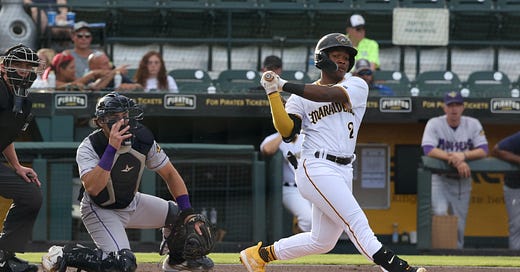



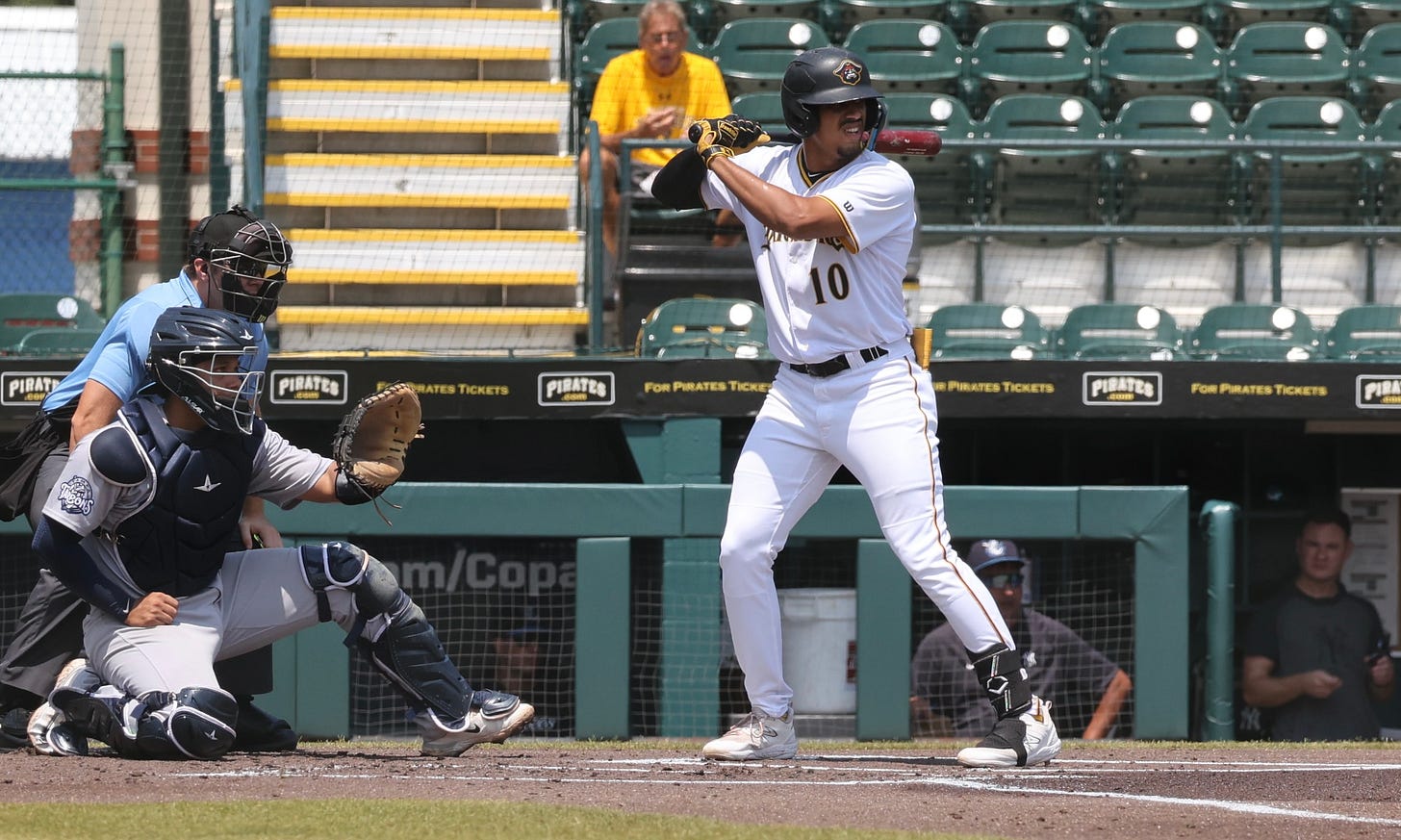

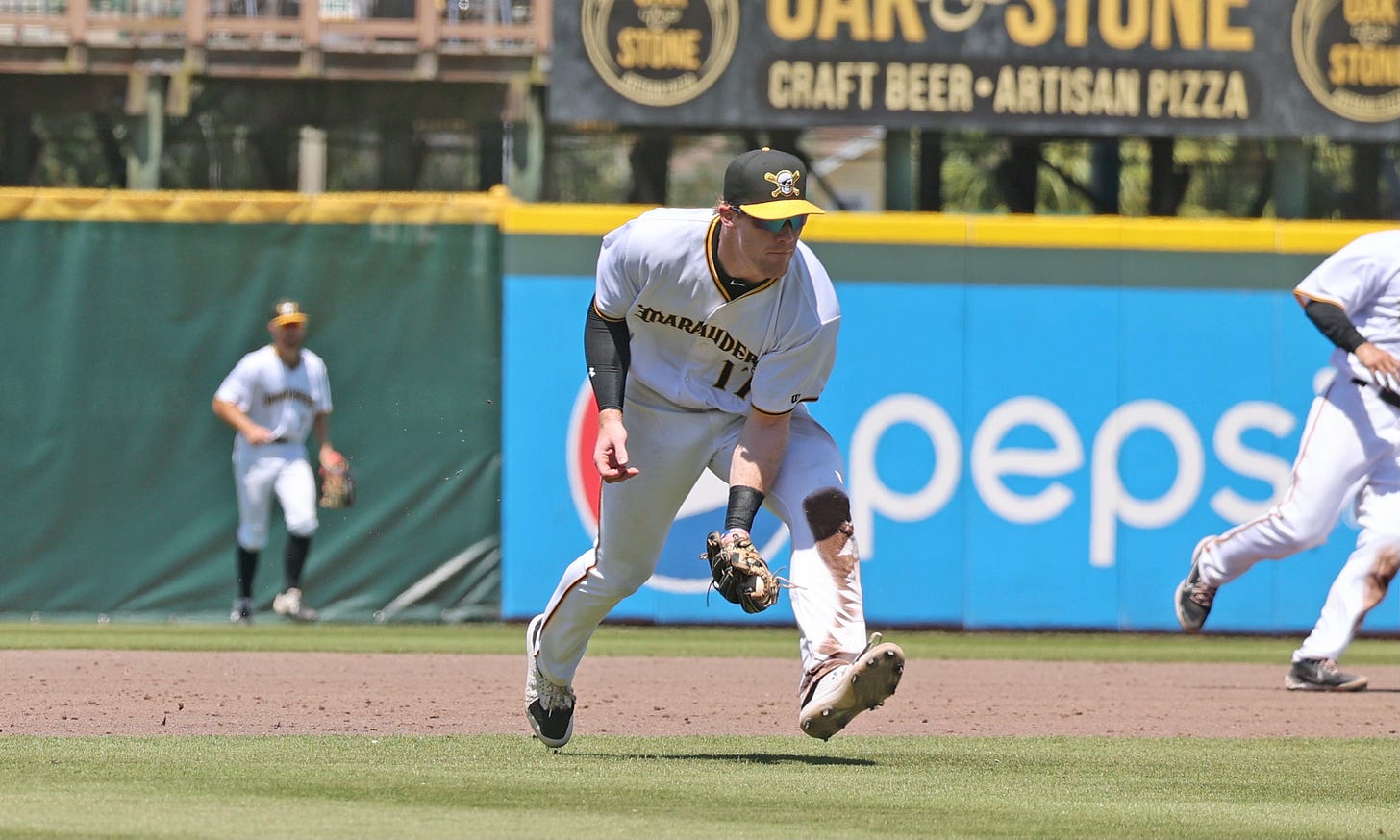
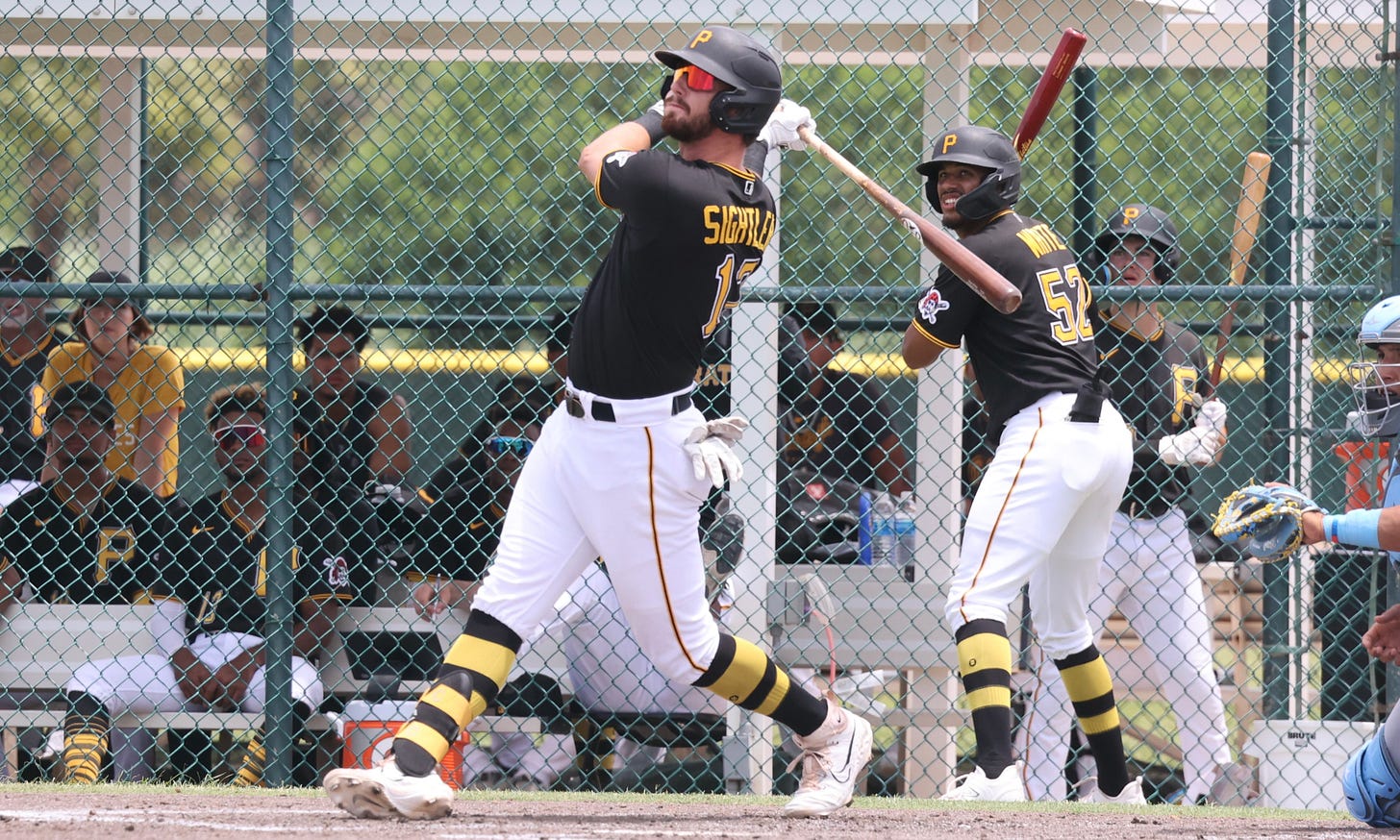





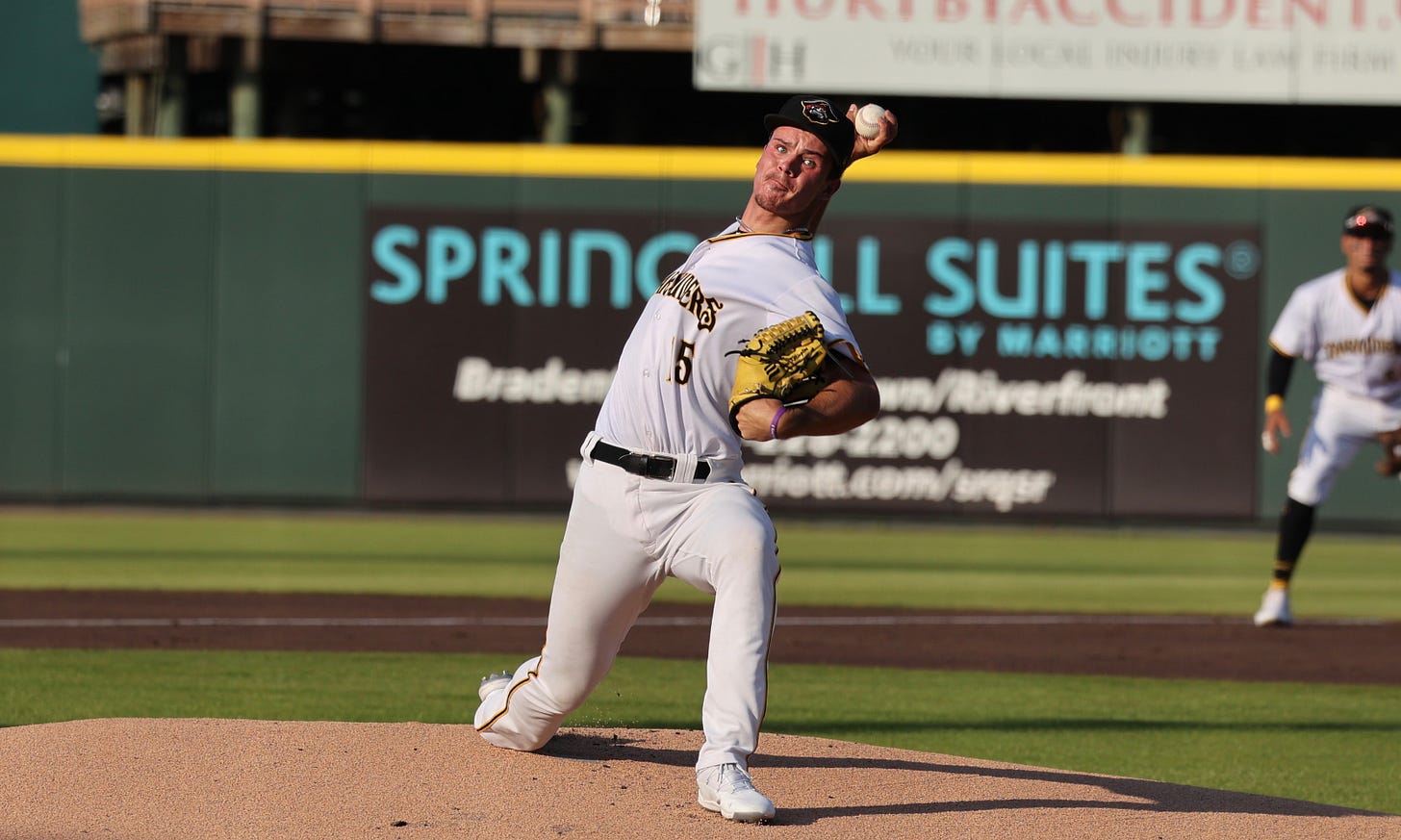


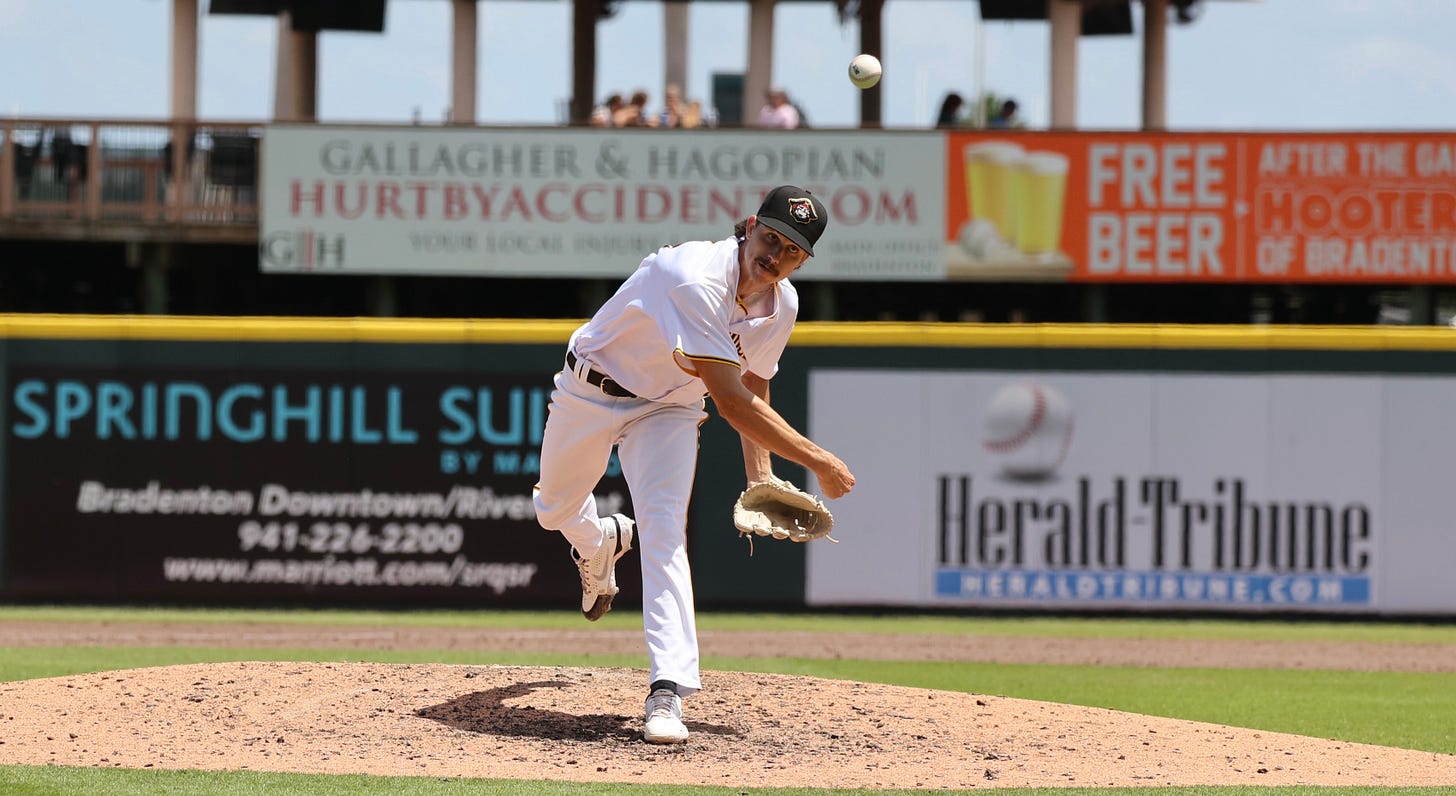
Good stuff Wilbur. These type articles are definitely where you fly the highest.
Thanks for all your hard work putting this info together.
Great stuff again WTM, thanks!